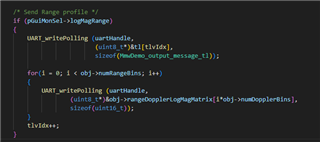Other Parts Discussed in Thread: DCA1000EVM, IWR1443, IWR1642BOOST
Tool/software:
Post:
Hello TI Experts,
I am working on SNR analysis for the IWR1443BOOST radar for a client and have encountered a significant gap between my theoretical and experimental SNR results. I would greatly appreciate any guidance to help resolve this issue. My method should also be applicable to other sensor modules from TI.
Theoretical SNR Calculation:
I used the following SNR equation:
SNR = (Pt * GRx * GTx * c2 * σ * N * Tr) / (fc 2 * (4π)3 * kT * NF * R4)
- Transmit Power Pt=0.0158 (12dBm)
- Antenna Gain Gt=Gr=7.94 (9 dB)
- Wavelength λ=3.797×10−3 (79 GHz) ( = c 2 / fc 2)
- System Temperature T=290K
- Noise Figure Nf=31.62 (15 dB)
- Chirp Repetition Period Tr=3042.58×10−6 s
- Number of Chirps per Frame N=16 (as per TI mmWave Sensing Estimator)
Experimental SNR:
- Environment: Measurements were conducted in an anechoic chamber (for almost conditions) and noise was averaged over 10 seconds to get an averaged noise floor (at each range bin).
- A target with known RCS was placed at different distances and relative received power recorded at each distance.
- using TI demo visualizer data was captured and analysed ( The configuration used was : SDK:2.1.0.4 , 2 Tx, 4 Rx, Best Range resolution, 77-81 GHz, 10 fps, Range Resolution 0.04 m , maximum unambiguous range 7.17m.
- SNR was measured at each distance by subtracting relative power (dB) - noise floor (dB) at each distance.
Issue:
Despite using the anechoic chamber noise floor for ideal conditions, the experimental SNR is consistently around 25 dB lower than the theoretical SNR calculated with the equations. This gap is larger than expected and persists across the measured distances (in the far field region)
Questions:
- Could this discrepancy be due to additional system losses or specific processing gains not accounted for in the Demo Visualizer?
- Are the relative received power and noise floor outputs in the Demo Visualizer scaled in a specific way?
- Are there any additional calibration steps or adjustments recommended to align the theoretical and experimental SNR values?
I would greatly appreciate any insights or suggestions to help resolve this gap and ensure accurate SNR analysis for the IWR1443BOOST.
Thank you for your assistance!



